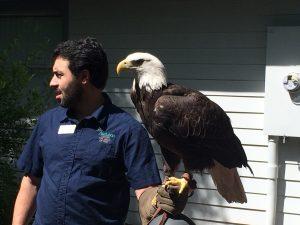What is a Bird of Prey?
The list of Birds of Prey include:
- eagles
- hawks
- osprey
- falcons
- vultures
- owls
- kestrels
Birds of prey have curved beaks and sharp talons on their feet. Many birds of prey strike their prey during flight in the air or on the ground. Birds of prey are often silent in their flight due to the pattern of feathers on their wings.
Migration
Many birds of prey migrate north in the spring to nest and fly south in the winter for food. Most species fly the same migration pattern and many places across the country have viewing areas to watch migration during certain times of the year.
Eagles
The majestic Bald Eagle is the national symbol for the United States. The Bald Eagle appears on the Great Seal that was created in 1782. The seal is found on the dollar bill. The Bald Eagle is only found in North America.
Facts:
- Eagles are full grown in 12 weeks.
- It takes five years for an eagle to reach maturity and a full white head.
- Eagles weigh between six and fourteen pounds.
- An eagle’s wingspan is six to 8 feet.
- An eagle’s nest is up to ten feet across and can weigh up to a ton.
- Eagles eat fish for up to 80% of their diet.
Hawks
There are several species of hawks. Most have amazing eyesight and can see up to three times better than humans. They will sit still on a tree branch or fence line for hours watching for a rodent or other prey.
Most hawks mate for life and stay in the same general area. They will nest in the same nest each year or make a new one close by. The offspring will travel great distances to find their own area to start a family.
Owls
- Great Horned Owl
- Snowy Owl
- Barn Owl
- Screech Owl
- Burrowing Owl
Owls are nocturnal meaning they are awake and hunt at night. Owls hunt the same territory as hawks. Hawks hunt during the day and owls at night. If you are out at dusk you might catch them hunting together.
Owls are called the great silent hunters. Their wings are designed so air flows through them and they come upon their prey silently. Owls have excellent vision and can detect the slightest movement. They also have amazing hearing and can hear a rodent underground.
Books:
Birds of Prey Field Guide for Young Naturalists, Jonathan P. Latimer
Owls, Gail Gibbons
Owl Tree, R. A. Montgomery
Lifecycle of an Owl, Ruth Thompson
My Side of the Mountain, Jean Craighead George
Raptor Force, a video by PBS
Jim Arnosky’s Wild World, Jim Arnosky
Thunder Birds: Nature’s Flying Predators, Jim Arnosky
Resources for this lesson
Learn more about Bald Eagles from the Cornell Lab of Ornithology
Learn about Bald Eagles from the Audubon Field Guide to North American Birds
Watch a video about a town in Alaska full of eagles.
Visit National Geographic Kids for information on Red Tail Hawks

